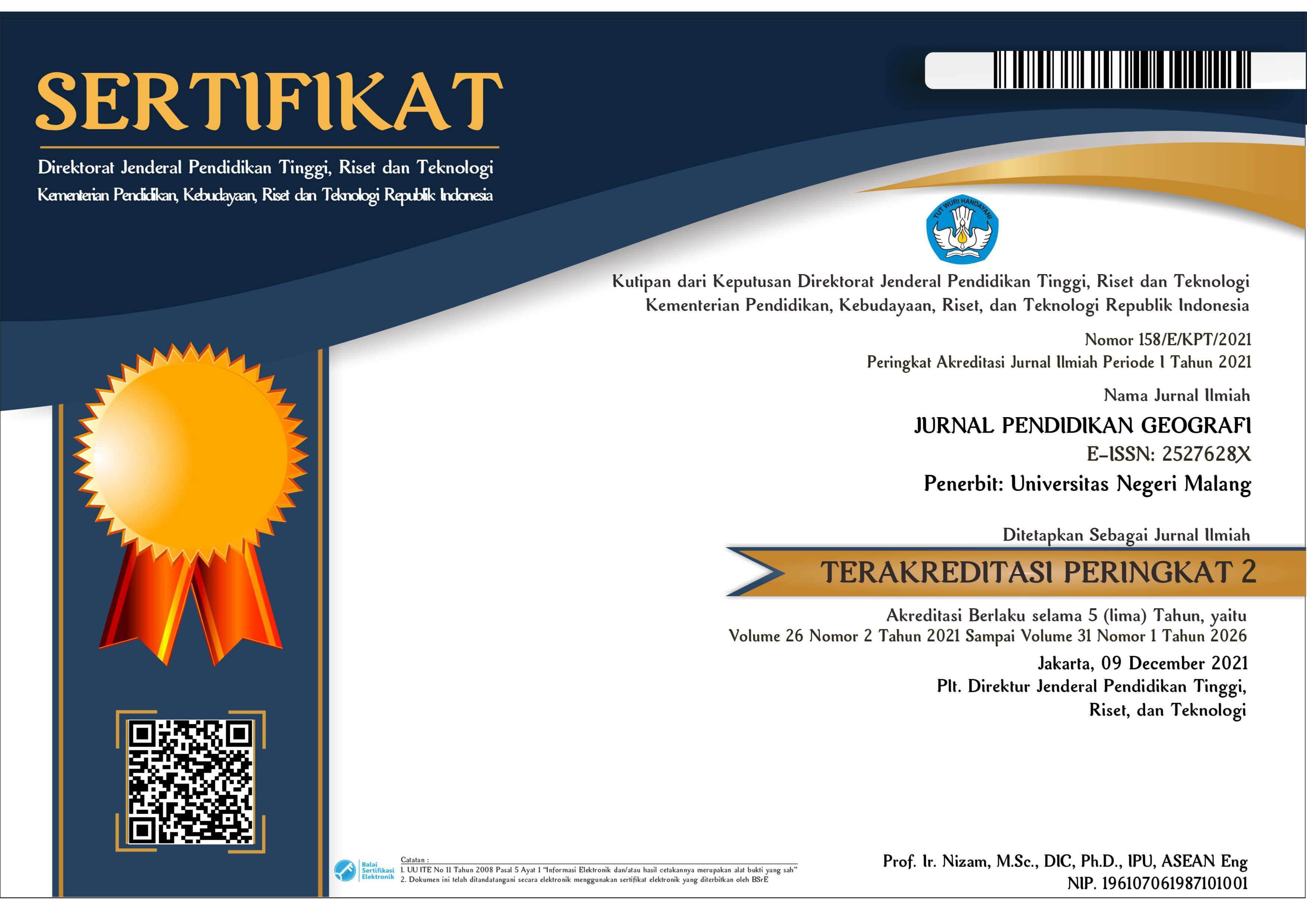Analysis on unconfined groundwater availability during dry and rainy season using dynamic approach in Ngemplak, Sleman, Yogyakarta, Indonesia
Abstract
Groundwater is a natural resource with disparity across the different regions throughout time. In comparison to surface water, the groundwater in unconfined aquifers is easily accessible and generally of good quality. Groundwater macro zoning is classified into three, namely water catchment areas, transition areas, and groundwater discharge areas. Based on the macro zoning, previous research has mostly been carried out in catchment areas and discharge areas with a focus on groundwater potential and temporary groundwater conditions. The dynamics of groundwater availability, especially in the water transition zone, has not been studied much, even though the dynamics of groundwater availability in the transition zone plays a vital role for areas in the discharge zone. This study identified the availability of groundwater during rainy and dry seasons in groundwater transition zone. Groundwater availability was assessed through a dynamic discharge approach. The study variables included the hydraulic conductivity of the aquifer, the hydraulic gradient, and the cross-sectional area of the aquifer. Dynamic discharges were analysed during the rainy and dry seasons. The results showed that the availability of groundwater during the rainy season was 4,333,906.1 liters/day and 3,898,850.4 liters/day during the dry season. Based on the calculation of the dynamic discharge (Q), the decrease in the quantity of groundwater is affected by the variable hydraulic gradient (I) and cross-sectional area of the aquifer (A). The numbers of these two variables are smaller during the dry season than the rainy season. The decrease in the quantity of groundwater during the dry season is of course closely related to reduced rainfall which is a source of infiltration and percolation. Reduced rainfall causes the groundwater level to decrease, then technically reduces the groundwater hydraulic gradient (I) and aquifer cross-sectional area variable (A). There was no indication of groundwater scarcity in the study area. This study can serve as a reference related to the application of dynamic discharge theory to assess groundwater availability. Periodic monitoring of groundwater quantity, rainwater harvesting, and intensification of water infiltration wells can be carried out as a recommendation to anticipate problems related to groundwater availability in the study area. This study can serve as a reference related to the application of dynamic discharge theory to assess groundwater availability.
Keywords
Full Text:
PDFReferences
Adji, T. N., & Sejati, S. P. (2014). Identification of groundwater potential zones within an area with various geomorphological units by using several field parameters and a GIS approach in Kulon Progo Regency, Java, Indonesia. Arabian Journal of Geosciences, 7(1), 161–172. https://doi.org/10.1007/s12517-012-0779-z
Arulbalaji, P., Padmalal, D., & Sreelash, K. (2019). GIS and AHP techniques based delineation of groundwater potential zones: A case study from Southern Western Ghats, India. Scientific Reports, 9(1), 1–17. https://doi.org/10.1038/s41598-019-38567-x
Central Bureau of Statistics of Sleman Regency. (2018). Kecamatan Ngemplak dalam Angka 2018.
Hendrayana, H., & Vicente, V. A. D. S. (2013). Cadangan air tanah berdasarkan geometri dan konfigurasi sistem akuifer cekungan air tanah Yogyakarta-Sleman. Prosiding Seminar Nasional Kebumian Ke-6, 356–370.
Irawan, L. Y., Arinta, D., Panoto, D., Pradana, I. H., Sulaiman, R., Nurrizqi, E., & Prasad, R. R. (2022). Identifikasi karakteristik akuifer dan potensi air tanah dengan metode geolistrik konfigurasi Schlumberger di Desa Arjosari, Kecamatan Kalipare, Kabupaten Malang. Jurnal Pendidikan Geografi: Kajian, Teori, dan Praktik dalam Bidang Pendidikan dan Ilmu Geografi, 27(1), 102–116. https://doi.org/10.17977/¬um017v27i12022p102-116
Lee, S., Hyun, Y., & Lee, M. J. (2019). Groundwater potential mapping using data mining models of big data analysis in Goyang-si, South Korea. Sustainability, 11(6), 1–21. https://doi.org/10.3390/su11061678
Lee, S., Hyun, Y., Lee, S., & Lee, M. J. (2020). Groundwater potential mapping using remote sensing and GIS-based machine learning techniques. Remote Sensing, 12(7), 1200.
Manny, L., Atmaja, R. R. S., & Putra, D. P. E. (2016). Groundwater level changes in shallow aquifer of Yogyakarta City, Indonesia: Distribution and causes. Journal of Applied Geology, 1(2), 89–99.
Meerkhan, H., Teixeira, J., Marques, J. E., Afonso, M. J., & Chaminé, H. I. (2016). Delineating groundwater vulnerability and protection zone mapping in fractured rock masses: Focus on the DISCO Index. Water, 8(462), 1–20. https://doi.org/10.3390/w8100462
Riasasi, W., & Sejati, S. P. (2019). Potential of groundwater to supply domestic water necessity in evacuation shelters of Merapi volcano eruption. IOP Conference Series: Earth and Environmental Science, 271(2019), 012014. https://doi.org/10.1088/1755-1315/271/1/012014
Santosa, L. W., & Adji, T. N. (2014). Karakteristik akuifer dan potensi airtanah Graben Bantul. Yogyakarta: Gadjah Mada University Press.
Sejati, S. P. (2021). Tingkat fluktuasi air tanah pada jangka pendek di Kecamatan Ngemplak, Kabupaten Sleman, Provinsi Daerah Istimewa Yogyakarta. Jurnal Teknologi Lingkungan, 22(1), 121–129. https://doi.org/10.29122/jtl.v22i1.3985
Sejati, S. P., & Adji, T. N. (2013). Kajian potensi air tanah di lereng selatan Gunung Api Merapi untuk mencukupi kebutuhan domestik pada hunian sementara. Yogyakarta: Universitas Gadjah Mada.
Sejati, S. P., & Saputra, A. (2022). Analysis of potential groundwater pollution in unconfined aquifer in colluvial footslopes and alluvial plains of the Pesing Watershed using integra of GOD and GIS web based methods. Jurnal Teknologi Lingkungan, 23(1), 44–54.
Todd, D. K. (2005). Groundwater hydrology. John Willey and Sons.
Trisdiyansyah, M. R., Listiawan, Y., Barkah, M. N., Sukiyah, E., & Hadian, M. S. D. (2022). Karakteristik fisika air tanah dan air permukaan serta hubungannya dengan kondisi geologi di lereng selatan Gunung Manglayang, Sumedang, Jawa Barat. Jurnal Pendidikan Geografi: Kajian, Teori, dan Praktik dalam Bidang Pendidikan dan Ilmu Geografi, 27(1), 88–101. https://doi.org/10.17977/um017v27i12022p88-101
Viossanges, M., Pavelic, P., Rebelo, L. M., Lacombe, G., & Sotoukee, T. (2018). Regional mapping of groundwater resources in data-scarce regions: The case of Laos. Hydrology, 5(1), 2. https://doi.org/-10.3390/¬hydrology5010002
Yeh, H., Cheng, Y., Lin, H., & Lee, C. (2016). Mapping groundwater recharge potential zone using a GIS approach in Hualian River, Taiwan. Sustainable Environment Research, 26(1), 33–43.
DOI: http://dx.doi.org/10.17977/um017v28i12023p38-51
Refbacks
- There are currently no refbacks.
Copyright (c) 2023 Jurnal Pendidikan Geografi: Kajian, Teori, dan Praktek dalam Bidang Pendidikan dan Ilmu Geografi

This work is licensed under a Creative Commons Attribution-ShareAlike 4.0 International License.
Jurnal Pendidikan Geografi: Kajian, Teori, dan Praktek dalam Bidang Pendidikan dan Ilmu Geografi is licensed under Creative Commons Attribution-ShareAlike 4.0 International License,
JPG Indexed By:
View My Stats









12.png)
